Encapsulating Calendula arvensis (Vaill.) L. Florets: UHPLC-HRMS Insights into Bioactive Compounds Preservation and Oral Bioaccessibility
Abstract
1. Introduction
2. Results and Discussion
2.1. Encapsulation Efficiency and FTIR Analysis
2.2. Evaluation of Cytotoxicity on the Caco-2 Cell Line
2.3. UHPLC-QqTOF-MS/MS Analysis before In Vitro Digestion
2.3.1. Phenols and Polyphenols
2.3.2. Triterpene Saponins
2.4. Bioaccessibility Assessment of Encapsulated Bioactive Compounds by In Vitro Digestion
2.5. Evaluation of Radical-Scavenging Capacity (RSC, %)
3. Materials and Methods
3.1. Plant Collection and Extraction
3.2. Floret Extract Encapsulation
3.2.1. Surface and Total Phenol Content in Encapsulates
3.2.2. Surface and Total Saponin Content in Encapsulates
3.2.3. Evaluation of Encapsulation Efficiency
3.3. FTIR Analysis of the Floret Encapsulate
3.4. Cytotoxicity Evaluation
3.5. Bioaccessibility Study
3.6. UHPLC-ESI-MS and MS/MS Analyses
3.7. Radical-Scavenging Capacity Assessment
4. Conclusions
Supplementary Materials
Author Contributions
Funding
Institutional Review Board Statement
Informed Consent Statement
Data Availability Statement
Acknowledgments
Conflicts of Interest
Sample Availability
References
- Baldi, A.; Bruschi, P.; Campeggi, S.; Egea, T.; Rivera, D.; Obón, C.; Lenzi, A. The Renaissance of Wild Food Plants: Insights from Tuscany (Italy). Foods 2022, 11, 300. [Google Scholar] [CrossRef] [PubMed]
- Łuczaj, Ł.; Pieroni, A.; Tardío, J.; Pardo-de-Santayana, M.; Sõukand, R.; Svanberg, I.; Kalle, R. Wild food plant use in 21st century Europe: The disappearance of old traditions and the search for new cuisines involving wild edibles. Acta Soc. Bot. Pol. 2012, 81, 359–370. [Google Scholar] [CrossRef]
- Łuczaj, L.; Pieroni, A. Nutritional Ethnobotany in Europe: From Emergency Foods to Healthy Folk Cuisines and Contemporary Foraging Trends. In Mediterranean Wild Edible Plants; Sánchez-Mata, M., Tardío, J., Eds.; Springer: New York, NY, USA, 2016; Chapter 3; pp. 33–56. [Google Scholar] [CrossRef]
- Ceccanti, C.; Landi, M.; Benvenuti, S.; Pardossi, A.; Guidi, L. Mediterranean wild edible plants: Weeds or “new functional crops”? Molecules 2018, 23, 2299. [Google Scholar] [CrossRef] [PubMed]
- Schulp, C.J.; Thuiller, W.; Verburg, P.H. Wild food in Europe: A synthesis of knowledge and data of terrestrial wild food as an ecosystem service. Ecol. Econ. 2014, 105, 292–305. [Google Scholar] [CrossRef]
- Marrelli, M.; Statti, G.; Conforti, F. A Review of Biologically Active Natural Products from Mediterranean Wild Edible Plants: Benefits in the Treatment of Obesity and Its Related Disorders. Molecules 2020, 25, 649. [Google Scholar] [CrossRef] [PubMed]
- Pinela, J.; Carvalho, A.M.; Ferreira, I.C.F.R. Wild edible plants: Nutritional and toxicological characteristics, retrieval strategies and importance for today’s society. Food Chem. Toxicol. 2017, 110, 165–188. [Google Scholar] [CrossRef]
- Pasta, S.; La Rosa, A.; Garfì, G.; Marcenò, C.; Gristina, A.S.; Carimi, F.; Guarino, R. An updated checklist of the sicilian native edible plants: Preserving the traditional ecological knowledge of century-old agro-pastoral landscapes. Front. Plant Sci. 2020, 11, 388. [Google Scholar] [CrossRef]
- Bacchetta, L.; Visioli, F.; Cappelli, G.; Caruso, E.; Martin, G.; Nemeth, E.; Bacchetta, G.; Bedini, G.; Wezel, A.; van Asseldonk, T.; et al. A manifesto for the valorization of wild edible plants. J. Ethnopharmacol. 2016, 191, 180–187. [Google Scholar] [CrossRef]
- Tardio, J.; Pardo De Santayana, M.; Morales, R. Ethnobotanical review of wild edible plants in Spain. Bot. J. Linn. Soc. 2006, 152, 27–71. [Google Scholar] [CrossRef]
- Geraci, A.; Amato, F.; Di Noto, G.; Bazan, G.; Schicchi, R. The wild taxa utilized as vegetables in Sicily (Italy): A traditional component of the Mediterranean diet. J. Ethnobiol. Ethnomed. 2018, 14, 14. [Google Scholar] [CrossRef]
- Ranfa, A.; Bodesmo, M. An Ethnobotanical investigation of traditional knowledge and uses of edible wild plants in the Umbria Region, Central Italy. J. Appl. Bot. Food Qual. 2017, 90, 246–258. [Google Scholar] [CrossRef]
- Licata, M.; Tuttolomondo, T.; Leto, C.; Virga, G.; Bonsangue, G.; Cammaleri, I.; Gennaro, M.C.; La Bella, S. A survey of wild plant species for food use in Sicily (Italy)—Results of a 3-year study in four Regional Parks. J. Ethnobiol. Ethnomed. 2016, 12, 12. [Google Scholar] [CrossRef] [PubMed]
- Hadjichambis, A.C.; Paraskeva-Hadjichambi, D.; Della, A.; Giusti, M.E.; De Pasquale, C.; Lenzarini, C.; Censorii, E.; Gonzales-Tejero, M.R.; Sanchez-Rojas, C.P.; Ramiro-Gutierrez, J.M.; et al. Wild and semi-domesticated food plant consumption in seven circum-Mediterranean areas. Int. J. Food Sci. Nutr. 2008, 59, 383–414. [Google Scholar] [CrossRef] [PubMed]
- Motti, R.; Bonanomi, G.; Lanzotti, V.; Sacchi, R. The contribution of wild edible plants to the mediterranean diet: An ethnobotanical case study along the coast of Campania (Southern Italy). Econ. Bot. 2020, 74, 249–272. [Google Scholar] [CrossRef]
- Fiorentino, M.; Gravina, C.; Piccolella, S.; Pecoraro, M.T.; Formato, M.; Stinca, A.; Pacifico, S.; Esposito, A. Calendula arvensis (Vaill.) L.: A systematic plant analysis of the polar extracts from its organs by UHPLC-HRMS. Foods 2022, 11, 247. [Google Scholar] [CrossRef]
- McSweeney, M.; Seetharaman, K. State of polyphenols in the drying process of fruits and vegetables. Crit. Rev. Food Sci. Nutr. 2015, 55, 660–669. [Google Scholar] [CrossRef] [PubMed]
- Diaconeasa, Z. Time-dependent degradation of polyphenols from thermally-processed berries and their in vitro antiproliferative effects against melanoma. Molecules 2018, 23, 2534. [Google Scholar] [CrossRef]
- Duque-Soto, C.; Quirantes-Piné, R.; Borrás-Linares, I.; Segura-Carretero, A.; Lozano-Sánchez, J. Characterization and influence of static in vitro digestion on bioaccessibility of bioactive polyphenols from an olive leaf extract. Foods 2022, 11, 743. [Google Scholar] [CrossRef]
- Neto, J.; de Almeida, T.; de Medeiros, J.; Vieira, L.; Moreira, T.; Maia, A.; Ribeiro, P.; de Brito, E.; Farias, D.; Carvalho, A. Impact of bioaccessibility and bioavailability of phenolic compounds in biological systems upon the antioxidant activity of the ethanolic extract of Triplaris gardneriana seeds. Biomed. Pharmacother. 2017, 88, 999–1007. [Google Scholar] [CrossRef]
- Ferreira-Santos, P.; Ibarz, R.; Fernandes, J.-M.; Pinheiro, A.C.; Botelho, C.; Rocha, C.M.R.; Teixeira, J.A.; Martín-Belloso, O. Encapsulated pine bark polyphenolic extract during gastrointestinal digestion: Bioaccessibility, bioactivity and oxidative stress prevention. Foods 2021, 10, 328. [Google Scholar] [CrossRef]
- Mazumder, M.A.R.; Ranganathan, T.V. Encapsulation of isoflavone with milk, maltodextrin and gum acacia improves its stability. Curr. Res. Food Sci. 2020, 2, 77–83. [Google Scholar] [CrossRef] [PubMed]
- Buljeta, I.; Pichler, A.; Šimunović, J.; Kopjar, M. Polysaccharides as carriers of polyphenols: Comparison of freeze-drying and spray-drying as encapsulation techniques. Molecules 2022, 27, 5069. [Google Scholar] [CrossRef] [PubMed]
- Yadav, K.; Bajaj, R.K.; Mandal, S.; Mann, B. Encapsulation of grape seed extract phenolics using whey protein concentrate, maltodextrin and gum arabica blends. J. Food Sci. Technol. 2020, 57, 426–434. [Google Scholar] [CrossRef] [PubMed]
- Pashazadeh, H.; Zannou, O.; Ghellam, M.; Koca, I.; Galanakis, C.M.; Aldawoud, T.M.S. Optimization and encapsulation of phenolic compounds extracted from maize waste by freeze-drying, spray-drying, and microwave-drying using maltodextrin. Foods 2021, 10, 1396. [Google Scholar] [CrossRef] [PubMed]
- Ravichandran, K.; Palaniraj, R.; Saw, N.M.; Gabr, A.M.; Ahmed, A.R.; Knorr, D.; Smetanska, I. Effects of different encapsulation agents and drying process on stability of betalains extract. J. Food Sci. Technol. 2014, 51, 2216–2221. [Google Scholar] [CrossRef] [PubMed]
- Ghandehari Yazdi, A.P.; Barzegar, M.; Sahari, M.A.; Ahmadi Gavlighi, H. Encapsulation of pistachio green hull phenolic compounds by spray drying. J. Agr. Sci. Technol. 2021, 23, 51–64. [Google Scholar]
- Grgić, J.; Šelo, G.; Planinić, M.; Tišma, M.; Bucić-Kojić, A. Role of the encapsulation in bioavailability of phenolic compounds. Antioxidants 2020, 9, 923. [Google Scholar] [CrossRef]
- Wongsa, P.; Phatikulrungsun, P.; Prathumthong, S. FT-IR characteristics, phenolic profiles and inhibitory potential against digestive enzymes of 25 herbal infusions. Sci. Rep. 2022, 12, 6631. [Google Scholar] [CrossRef]
- Djikanović, D.; Devečerski, A.; Steinbach, G.; Simonović, J.; Matović, B.; Garab, G.; Kalauzi, A.; Radotić, K. Comparison of macromolecular interactions in the cell walls of hardwood, softwood and maize by fluorescence and FTIR spectroscopy, differential polarization laser scanning microscopy and X-ray diffraction. Wood Sci. Technol. 2016, 50, 547–566. [Google Scholar] [CrossRef]
- Todorović, A.; Šturm, L.; Salević-Jelić, A.; Lević, S.; Osojnik Črnivec, I.G.; Prislan, I.; Skrt, M.; Bjeković, A.; Poklar Ulrih, N.; Nedović, V. Encapsulation of bilberry extract with maltodextrin and gum arabic by freeze-drying: Formulation, characterisation, and storage stability. Processes 2022, 10, 1991. [Google Scholar] [CrossRef]
- Matwijczuk, A.; Budziak-Wieczorek, I.; Czernel, G.; Karcz, D.; Barańska, A.; Jedlińska, A.; Samborska, K. Classification of honey powder composition by FTIR spectroscopy coupled with chemometric analysis. Molecules 2022, 27, 3800. [Google Scholar] [CrossRef] [PubMed]
- Arnold, A.R.; Chassaing, B. Maltodextrin, Modern Stressor of the Intestinal Environment. Cell. Mol. Gastroenterol. Hepatol. 2019, 7, 475–476. [Google Scholar] [CrossRef] [PubMed]
- Jovanović Galović, A.; Jovanović Lješković, N.; Vidović, S.; Vladić, J.; Jojić, N.; Ilić, M.; Srdić Rajić, T.; Kojić, V.; Jakimov, D. The Effects of Resveratrol-Rich Extracts of Vitis vinifera Pruning Waste on HeLa, MCF-7 and MRC-5 Cells: Apoptosis, Autophagia and Necrosis Interplay. Pharmaceutics 2022, 14, 2017. [Google Scholar] [CrossRef]
- Desai, N.M.; Haware, D.J.; Basavaraj, K.; Murthy, P.S. Microencapsulation of antioxidant phenolic compounds from green coffee. Prep. Biochem. Biotechnol. 2019, 49, 400–406. [Google Scholar] [CrossRef] [PubMed]
- Zorzenon, M.R.T.; Formigoni, M.; da Silva, S.B.; Hodas, F.; Piovan, S.; Ciotta, S.R.; Jansen, C.A.; Dacome, A.S.; Pilau, E.J.; Mareze-Costa, C.E.; et al. Spray drying encapsulation of stevia extract with maltodextrin and evaluation of the physicochemical and functional properties of produced powders. J. Food Sci. 2020, 85, 3590–3600. [Google Scholar] [CrossRef] [PubMed]
- Pacifico, S.; Piccolella, S.; Nocera, P.; Tranquillo, E.; Dal Poggetto, F.; Catauro, M. New insights into phenol and polyphenol composition of Stevia rebaudiana leaves. J. Pharm. Biomed. Anal. 2019, 163, 45–57. [Google Scholar] [CrossRef]
- Tsagkaris, A.S.; Louckova, A.; Jaegerova, T.; Tokarova, V.; Hajslova, J. The in vitro inhibitory effect of selected Asteraceae plants on pancreatic lipase followed by phenolic content identification through Liquid Chromatography High Resolution Mass Spectrometry (LC-HRMS). Int. J. Mol. Sci. 2022, 23, 11204. [Google Scholar] [CrossRef] [PubMed]
- Grati, W.; Samet, S.; Bouzayani, B.; Ayachi, A.; Treilhou, M.; Téné, N.; Mezghani-Jarraya, R. HESI-MS/MS Analysis of Phenolic Compounds from Calendula aegyptiaca fruits extracts and evaluation of their antioxidant activities. Molecules 2022, 27, 2314. [Google Scholar] [CrossRef]
- Kannan, R.; Arumugam, R.; Anantharaman, P. Fourier Transform Infrared Spectroscopy analysis of seagrass polyphenols. Curr. Bioact. Compd. 2011, 7, 118–125. [Google Scholar] [CrossRef]
- Sinyayev, V.; Gulparshyn, A.; Toxeitova, G.; Aigul, A.; Batyrbayeva, A.; Sassykova, L.; Azhigulova, R.; Sakhipov, Y. A comparative investigation of the IR spectra of a carbohydrate series. J. Chem. Technol. Metall. 2020, 55, 724–729. [Google Scholar]
- Böttcher, S.; Drusch, S. Saponins-Self-assembly and behavior at aqueous interfaces. Adv. Colloid Interface Sci. 2017, 243, 105–113. [Google Scholar] [CrossRef]
- Zeng, L.; Xiang, R.; Fu, C.; Qu, Z.; Liu, C. The Regulatory effect of chlorogenic acid on gut-brain function and its mechanism: A systematic review. Biomed. Pharmacother. 2022, 149, 112831. [Google Scholar] [CrossRef] [PubMed]
- Majdoub, Y.O.E.; Ginestra, G.; Mandalari, G.; Dugo, P.; Mondello, L.; Cacciola, F. The digestibility of Hibiscus sabdariffa L. polyphenols using an in vitro human digestion model and evaluation of their antimicrobial activity. Nutrients 2021, 13, 2360. [Google Scholar] [CrossRef] [PubMed]
- Xie, L.; Deng, Z.; Zhang, J.; Dong, H.; Wang, W.; Xing, B.; Liu, X. Comparison of flavonoid O-glycoside, C-glycoside and their aglycones on antioxidant capacity and metabolism during in vitro digestion and in vivo. Foods 2022, 11, 882. [Google Scholar] [CrossRef] [PubMed]
- Spencer, J.P. Metabolism of tea flavonoids in the gastrointestinal tract. J. Nutr. 2003, 133, 3255S–3261S. [Google Scholar] [CrossRef]
- Tarko, T.; Duda-Chodak, A.; Zajac, N. Digestion and absorption of phenolic compounds assessed by in vitro simulation methods. A review. Rocz Panstw Zakl Hig. 2013, 64, 79–84. [Google Scholar]
- Vergara, C.; Pino, M.T.; Zamora, O.; Parada, J.; Pérez, R.; Uribe, M.; Kalazich, J. Microencapsulation of anthocyanin extracted from purple flesh cultivated potatoes by spray drying and its effects on in vitro gastrointestinal digestion. Molecules 2020, 25, 722. [Google Scholar] [CrossRef]
- Formato, M.; Piccolella, S.; Zidorn, C.; Vastolo, A.; Calabrò, S.; Cutrignelli, M.I.; Pacifico, S. UHPLC-ESI-QqTOF analysis and in vitro rumen fermentation for exploiting Fagus sylvatica leaf in ruminant diet. Molecules 2022, 27, 2217. [Google Scholar] [CrossRef]
- Abdel-Aty, A.M.; Barakat, A.Z.; Mohamed, S.A. Garden cress gum and maltodextrin as microencapsulation coats for entrapment of garden cress phenolic-rich extract: Improved thermal stability, storage stability, antioxidant and antibacterial activities. Food Sci. Biotechnol. 2022. [Google Scholar] [CrossRef]
- Borrelli, F.; Pagano, E.; Formisano, C.; Piccolella, S.; Fiorentino, A.; Tenore, G.C.; Izzo, A.A.; Rigano, D.; Pacifico, S. Hyssopus officinalis subsp. aristatus: An unexploited wild-growing crop for new disclosed bioactives. Ind. Crops Prod. 2019, 140, 111594. [Google Scholar] [CrossRef]
- Formato, M.; Piccolella, S.; Zidorn, C.; Pacifico, S. UHPLC-HRMS Analysis of Fagus sylvatica (Fagaceae) Leaves: A Renewable Source of Antioxidant Polyphenols. Antioxidants 2021, 10, 1140. [Google Scholar] [CrossRef] [PubMed]
- Minekus, M.; Alminger, M.; Alvito, P.; Balance, S.; Bohn, T.; Bourlieu, C.; Carrière, F.; Boutrou, R.; Corredig, M.; Dupont, D.; et al. A standardised static in vitro digestion method suitable for food—An international consensus. Food Funct. 2014, 5, 1113–1124. [Google Scholar] [CrossRef] [PubMed]
- Piccolella, S.; Bianco, A.; Crescente, G.; Santillo, A.; Chieffi Baccari, G.; Pacifico, S. Recovering Cucurbita pepo cv. ‘Lungo Fiorentino’ wastes: UHPLC-HRMS/MS metabolic profile, the basis for establishing their nutra- and cosmeceutical valorisation. Molecules 2019, 24, 1479. [Google Scholar] [CrossRef] [PubMed]
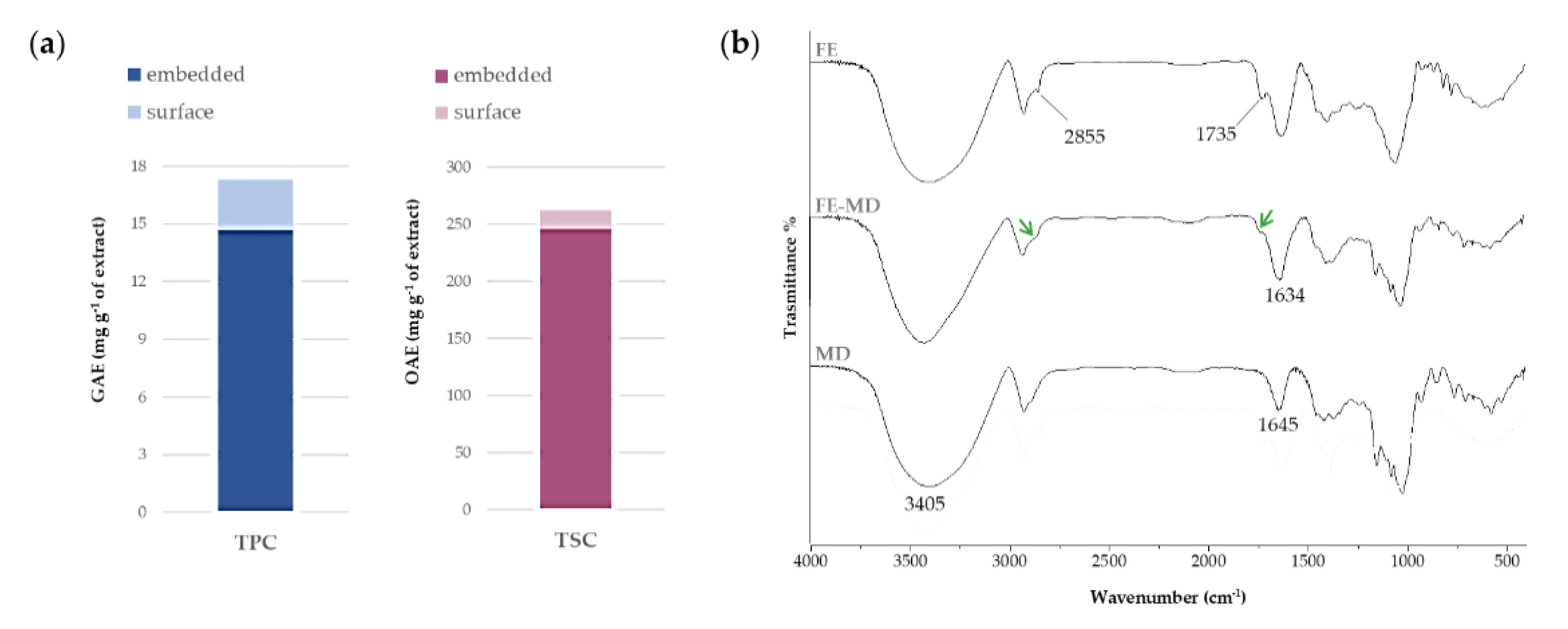
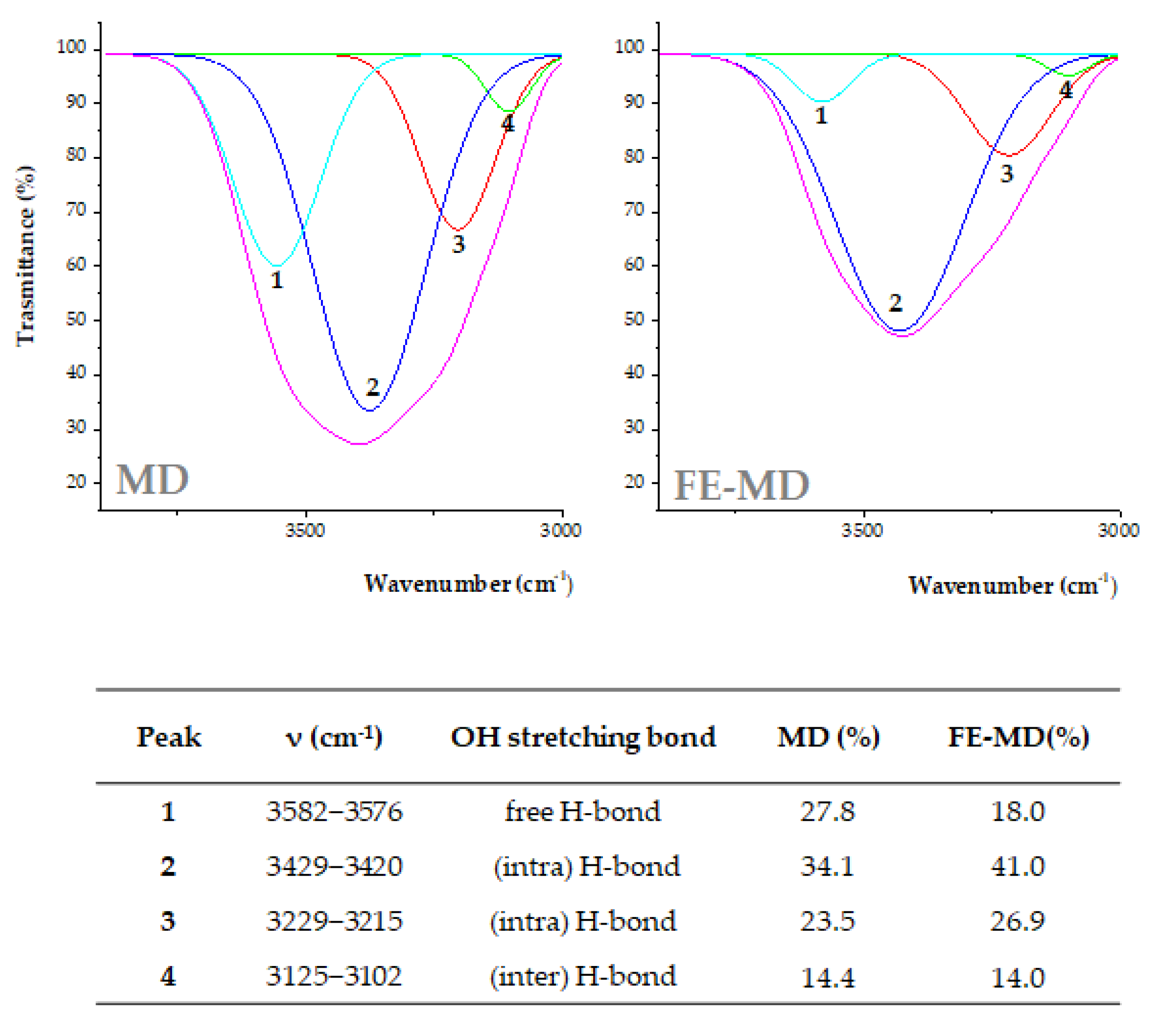
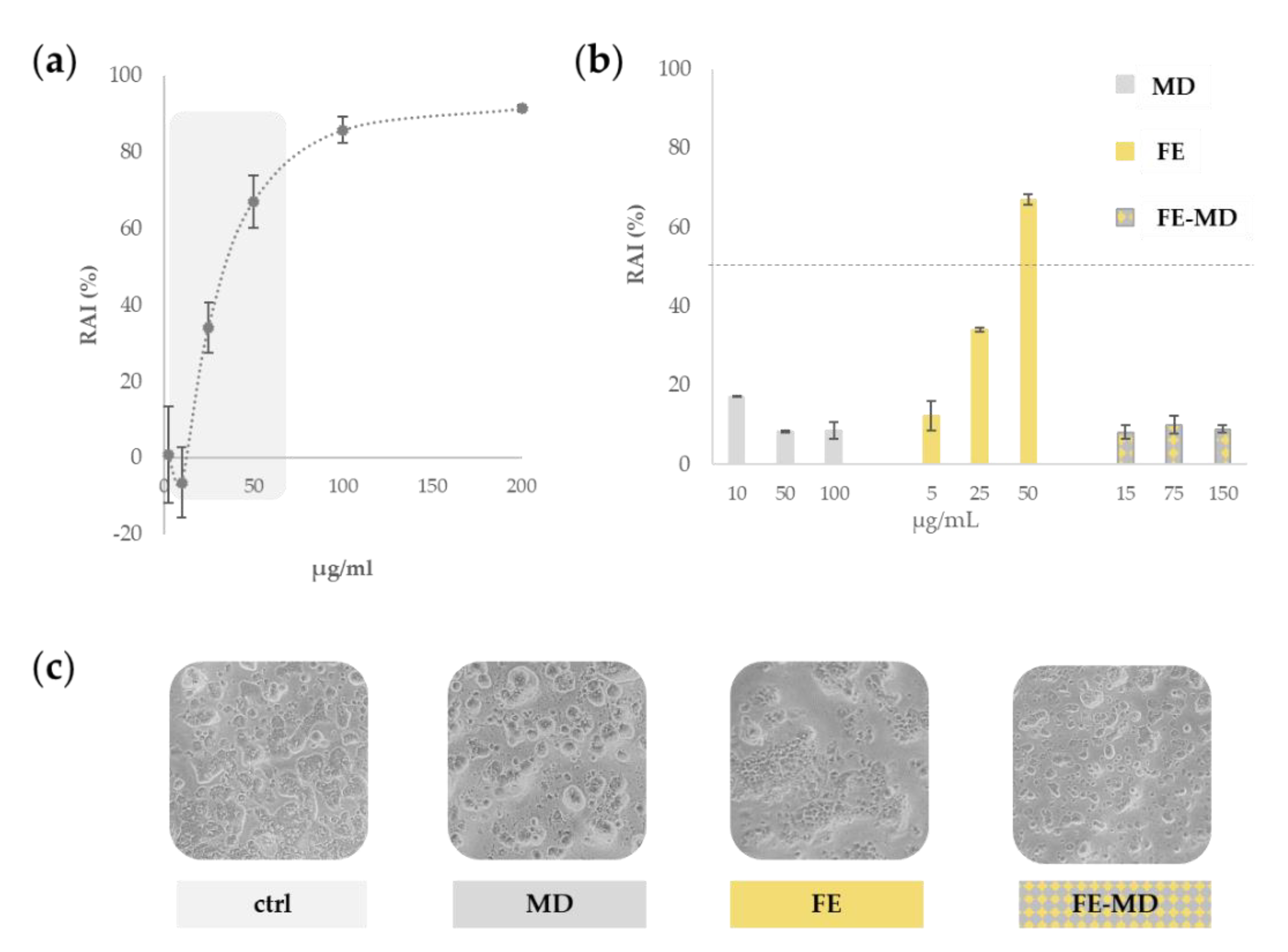

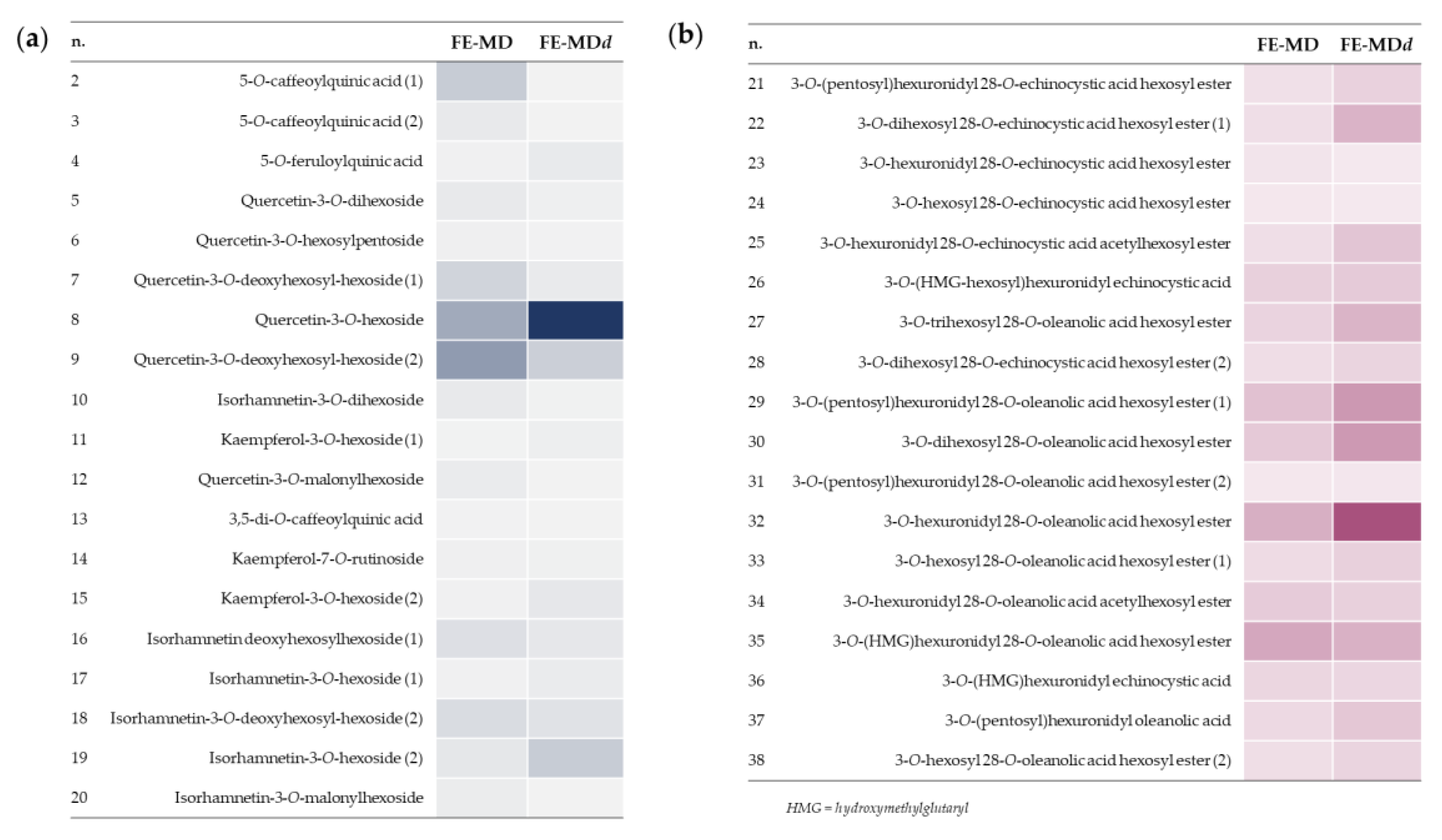
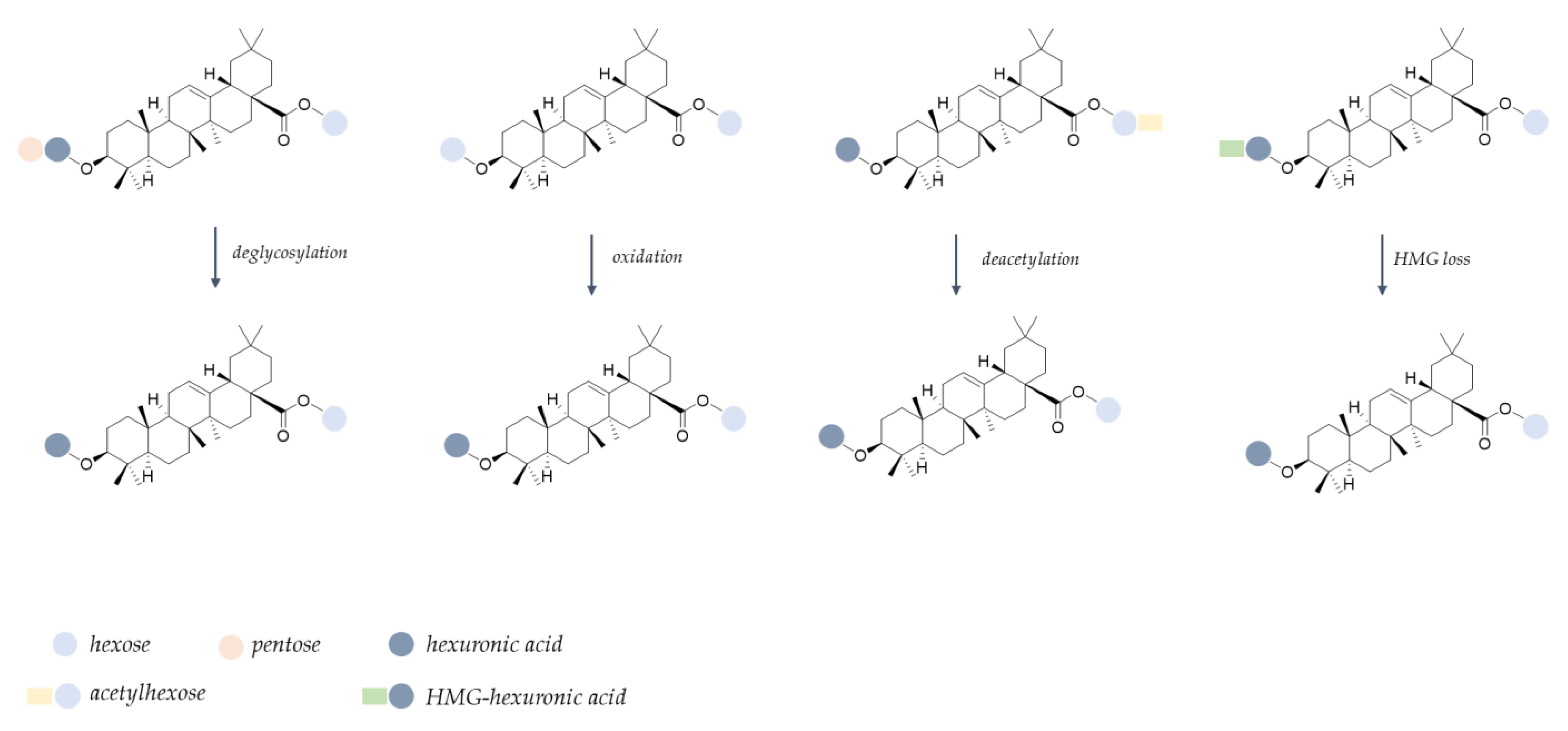
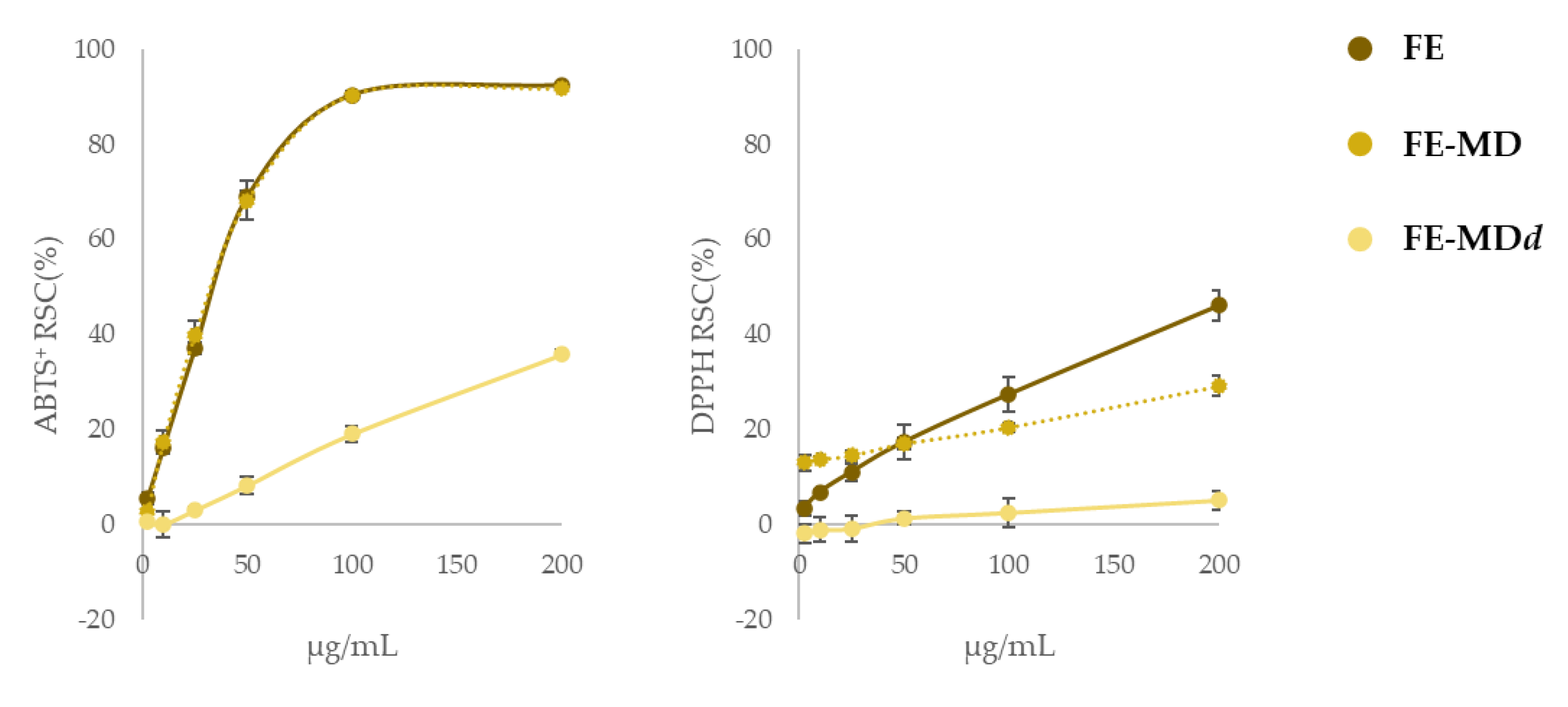
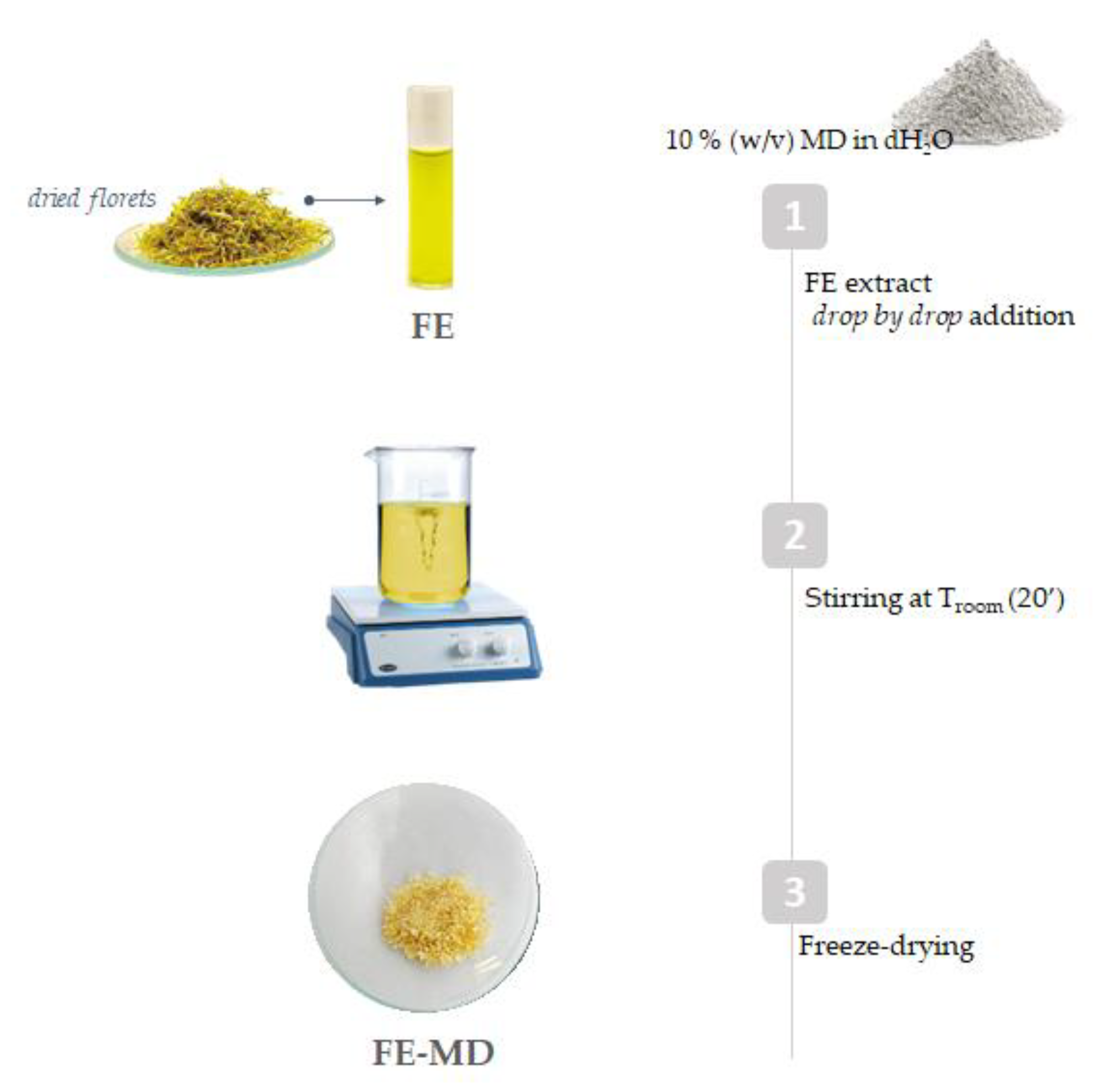
| Peak | Rt (min) | Molecular Formula | RDB | [M − H]− Found (m/z) | [M − H]− Calcd. (m/z) | Error (ppm) | MS/MS Fragments (m/z) | Tentative Assignment |
|---|---|---|---|---|---|---|---|---|
| 1 | 0.288 | C12H22O11 | 2.0 | 377.0890 [M + Cl−]− | n.c. | n.c. | 377.0873, 341.1108, 179.0568, 161.0461, 119.0354, 113.0252, 89.0248 | Dihexose |
| 2 | 2.677 | C16H18O9 | 8.0 | 353.0880 | 353.0878 | 0.5 | 191.0566, 85.0295 | 5-O-caffeoylquinic acid (1) |
| 3 | 3.126 | C16H18O9 | 8.0 | 353.0880 | 353.0878 | 0.5 | 191.0568 | 5-O-caffeoylquinic acid (2) |
| 4 | 5.658 | C17H20O9 | 8.0 | 367.1043 | 367.1035 | 2.3 | 193.0506, 191.0561, 173.0482, 134.0372, 93.0349 | 5-O-feruloylquinic acid |
| 5 | 7.341 | C27H30O17 | 13.0 | 625.1410 | 625.1410 | 0.0 | 625.1410, 301.0354, 300.0275, 271.0243, 255.0296, 178.9995, 151.0045 | Quercetin-3-O-dihexoside |
| 6 | 7.503 | C26H28O16 | 13.0 | 595.1307 | 595.1305 | 0.4 | 595.1307, 301.0354, 300.0276, 271.0253, 255.0288 | Quercetin-3-O-hexosylpentoside |
| 7 | 7.751 | C27H30O16 | 13.0 | 609.1463 | 609.1461 | 0.3 | 609.1461, 301.03547, 300.0277, 271.0250, 255.0302 | Quercetin-3-O-hexosyldeoxyhexoside (1) |
| 8 | 7.848 | C21H20O12 | 12.0 | 463.0885 | 463.0882 | 0.6 | 463.0885, 301.0354, 300.0376, 271.0243, 255.0294 | Quercetin-3-O-hexoside |
| 9 | 8.197 | C27H30O16 | 13.0 | 609.1463 | 609.1461 | 0.3 | 609.1463, 301.0354, 300.0276, 271.0244, 255.0296, 243.0299, 178.9994, 151.0051 | Quercetin-3-O-hexosyldeoxyhexoside (2) |
| 10 | 8.674 | C28H32O17 | 13.0 | 639.1562 | 639.1567 | −0.7 | 639.1562, 315.0510, 314.0431, 300.0264, 299.0197, 271.0253 | Isorhamnetin-3-O-dihexoside |
| 11 | 8.889 | C21H20O11 | 12.0 | 447.0935 | 447.0933 | 0.5 | 447.0935, 327.0525, 285.0405, 284.0326, 255.0304, 227.0353, 174.9581 | Kaempferol-3-O-hexoside (1) |
| 12 | 8.928 | C24H22O15 | 14.0 | 549.0888 | 549.0886 | 0.4 | 505.0988, 463.0885, 301.0354, 300.0284, 271.0255, 255.0306, 243.0293 | Quercetin-3-O-malonylhexoside |
| 13 | 9.147 | C25H24O12 | 14.0 | 515.1196 | 515.1195 | 0.2 | 353.0878, 191.0561, 179.0347, 135.0460 | 3,5-di-O-caffeoylquinic acid |
| 14 | 9.446 | C27H30O15 | 13.0 | 593.1515 | 593.1512 | 0.5 | 593.1515, 285.0405, 284.0320, 255.0297, 227.0347 | Kaempferol-7-O-rutinoside |
| 15 | 9.484 | C21H20O11 | 12.0 | 447.0935 | 447.0933 | 0.5 | 447.0935, 327.0487, 285.0405, 284.0325, 255.0297, 227.0353, 151.0026 | Kaempferol-3-O-hexoside (2) |
| 16 | 9.544 | C28H32O16 | 13.0 | 623.1618 | 623.1618 | 0.1 | 623.1618, 315.0510, 314.0433, 299.0207, 271.0254 | Isorhamnetin hexosyldeoxyhexoside (1) |
| 17 | 9.740 | C22H22O12 | 12.0 | 477.1040 | 477.1039 | 0.3 | 477.1040, 315.0510, 314.0441, 300.0265, 299.0200, 285.0420, 271.0258, 243.0313, 151.0065 | Isorhamnetin-3-O-hexoside (1) |
| 18 | 9.937 | C28H32O16 | 13.0 | 623.1618 | 623.1618 | 0.1 | 623.1618, 315.0510, 314.0430, 300.0272, 299.0195, 271.0245 | Isorhamnetin-3-O-hexosyldeoxyhexoside (2) |
| 19 | 10.015 | C22H22O12 | 12.0 | 477.1040 | 477.1039 | 0.3 | 477.1040, 357.0603, 315.0510, 314.0428, 300.0264, 299.0185, 285.0402, 271.0243, 257.0453, 243.0297 | Isorhamnetin-3-O-hexoside (2) |
| 20 | 11.147 | C25H24O15 | 14.0 | 563.1042 | 563.1042 | −0.1 | 519.1181, 315.0510, 314.0428, 300.0269, 299.0194, 271.0244, 255.0278, 243.0286 | Isorhamnetin-3-O-malonylhexoside |
| 21 | 15.159 | C47H74O19 | 11.0 | 941.4790 | 941.4752 | 4.1 | 941.4790, 779.4207, 717.4229, 629.3699, 585.3797, 471.3480, 407.3319 | 3-O-(pentosyl)hexuronidyl 28-O-echinocystic acid hexosyl ester |
| 22 | 15.440 | C48H78O19 | 10.0 | 1003.5119 * | 1003.5119 | 0.0 | 795.4543, 733.4525, 633.3981, 615.3903, 471.3419, 407.3305, 119.0342, 113.0236, 101.0237, 89.0232 | 3-O-dihexosyl 28-O-echinocystic acid hexosyl ester (1) |
| 23 | 15.635 | C42H66O15 | 10.0 | 809.4369 | 809.4329 | 4.9 | 809.4337, 689.3950, 647.3855, 585.3819, 513.3615, 471.3484, 407.3309, 391.3031 | 3-O-hexuronidyl 28-O-echinocystic acid hexosyl ester |
| 24 | 16.099 | C42H68O14 | 8.0 | 841.4633* | 841.4591 | 5.0 | 633.4030, 587.3957, 407.3348, 101.0241 | 3-O-hexosyl 28-O-echinocystic acid hexosyl ester |
| 25 | 16.490 | C44H68O16 | 11.0 | 851.4455 | 851.4435 | 2.4 | 809.4329, 689.3922, 585.3859, 539.3794, 471.3502, 407.3337, 113.0238 | 3-O-hexuronidyl 28-O-echinocystic acid acetylhexosyl ester |
| 26 | 16.635 | C48H74O19 | 12.0 | 953.4792 | 953.4752 | 4.2 | 809.4329, 689.3908, 647.3816, 629.3727, 585.3792, 471.3464, 407.3301, 113.0232 | 3-O-(hydroxymethylglutarylhexosyl)hexuronidyl echinocystic acid |
| 27 | 17.009 | C54H88O23 | 10.0 | 1149.5700 * | 1149.5698 | 0.2 | 941.5115, 779.4576, 617.4046, 599.3933, 581.3822, 551,3725, 455.3506 | 3-O-trihexosyl 28-O-oleanolic acid hexosyl ester |
| 28 | 17.524 | C48H78O19 | 10.0 | 1003.5100 * | 1003.5119 | −1.9 | 957.5079, 795.4570, 777.4456, 733.4562, 633.4042, 615.3939, 567.3686, 471.3495, 407.3321, 113.0234, 101.0237 | 3-O-dihexosyl 28-O-echinocystic acid hexosyl ester (2) |
| 29 | 17.683 | C47H74O18 | 11.0 | 925.4810 | 925.4802 | 0.9 | 925.4802, 763.4253, 719.4352, 701.4265, 629.4045, 613.3731, 587.3929, 569.3839, 551.3730, 523.3779, 497.3614, 455.3506, 453.3341, 437.3398, 423.3254, 407.3281 | 3-O-(pentosyl)hexuronidyl 28-O-oleanolic acid hexosyl ester (1) |
| 30 | 18.020 | C48H78O18 | 9.0 | 987.5218 * | 987.5170 | 4.8 | 779.4587, 617.4060, 599.39409, 455.3512 | 3-O-dihexosyl 28-O-oleanolic acid hexosyl ester |
| 31 | 18.395 | C47H74O18 | 11.0 | 925.4812 | 925.4802 | 1.0 | 925.4812, 763.4269, 701.4293, 629.4091, 613.3749, 569.3854, 523.3827, 497.3650, 455.3526, 453.3475 | 3-O-(pentosyl)hexuronidyl 28-O-oleanolic acid hexosyl ester (2) |
| 32 | 18.475 | C42H66O14 | 10.0 | 793.4390 | 793.4380 | 1.3 | 793.4390, 631.3866, 569.3860, 497.3633, 455.3523, 437.3403, 113.0240 | 3-O-hexuronidyl 28-O-oleanolic acid hexosyl ester |
| 33 | 18.973 | C42H68O13 | 8.0 | 825.4687 * | 825.4652 | 4.7 | 617.4069 | 3-O-hexosyl 28-O-oleanolic acid hexosyl ester (1) |
| 34 | 19.473 | C44H68O15 | 11.0 | 835.4501 | 835.4485 | 1.9 | 793.4390, 673.3993, 613.3799, 569.3885, 551.3763, 497.3660, 455.3536, 437.3458 | 3-O-hexuronidyl 28-O-oleanolic acid acetylhexosyl ester |
| 35 | 19.633 | C48H74O18 | 12.0 | 937.4812 | 937.4802 | 1.0 | 793.4390, 673.39682, 631.3862, 613.3753, 569.3851, 497.3628, 455.3520, 437.3411 | 3-O-(hydroxymethylglutaryl)hexuronidyl 28-O-oleanolic acid hexosyl ester |
| 36 | 20.423 | C42H64O14 | 11.0 | 791.4235 | 791.4223 | 1.5 | 647.3791, 471.3480, 407.3286, 391.2967, 113.0225 | 3-O-(hydroxymethylglutaryl)hexuronidyl echinocystic acid |
| 37 | 22.256 | C41H64O13 | 10.0 | 763.4303 | 763.4274 | 3.8 | 763.4303, 613.3767, 569.3879, 537.3592, 497.3602, 455.3531, 453.3356, 437.3426, 407.3333 | 3-O-(pentosyl)hexuronidyl oleanolic acid |
| 38 | 22.615 | C42H68O13 | 8.0 | 825.4662 * | 825.4652 | 2.8 | 617.4059, 599.3959, 455.3528, 113.0231, 101.0235 | 3-O-hexosyl 28-O-oleanolic acid hexosyl ester (2) |
Disclaimer/Publisher’s Note: The statements, opinions and data contained in all publications are solely those of the individual author(s) and contributor(s) and not of MDPI and/or the editor(s). MDPI and/or the editor(s) disclaim responsibility for any injury to people or property resulting from any ideas, methods, instructions or products referred to in the content. |
© 2022 by the authors. Licensee MDPI, Basel, Switzerland. This article is an open access article distributed under the terms and conditions of the Creative Commons Attribution (CC BY) license (https://creativecommons.org/licenses/by/4.0/).
Share and Cite
Fiorentino, M.; Piccolella, S.; Gravina, C.; Stinca, A.; Esposito, A.; Catauro, M.; Pacifico, S. Encapsulating Calendula arvensis (Vaill.) L. Florets: UHPLC-HRMS Insights into Bioactive Compounds Preservation and Oral Bioaccessibility. Molecules 2023, 28, 199. https://doi.org/10.3390/molecules28010199
Fiorentino M, Piccolella S, Gravina C, Stinca A, Esposito A, Catauro M, Pacifico S. Encapsulating Calendula arvensis (Vaill.) L. Florets: UHPLC-HRMS Insights into Bioactive Compounds Preservation and Oral Bioaccessibility. Molecules. 2023; 28(1):199. https://doi.org/10.3390/molecules28010199
Chicago/Turabian StyleFiorentino, Marika, Simona Piccolella, Claudia Gravina, Adriano Stinca, Assunta Esposito, Michelina Catauro, and Severina Pacifico. 2023. "Encapsulating Calendula arvensis (Vaill.) L. Florets: UHPLC-HRMS Insights into Bioactive Compounds Preservation and Oral Bioaccessibility" Molecules 28, no. 1: 199. https://doi.org/10.3390/molecules28010199
APA StyleFiorentino, M., Piccolella, S., Gravina, C., Stinca, A., Esposito, A., Catauro, M., & Pacifico, S. (2023). Encapsulating Calendula arvensis (Vaill.) L. Florets: UHPLC-HRMS Insights into Bioactive Compounds Preservation and Oral Bioaccessibility. Molecules, 28(1), 199. https://doi.org/10.3390/molecules28010199











